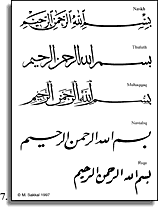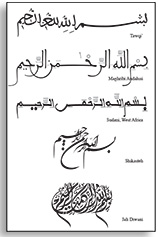Part 4 of 5 articles The Art of Arabic Calligraphy |
|
The Cursive Styles© Mamoun Sakkal 1993, updated 12/27/2016 |
|
The cursive script dates back at least to the first decades of the Muslim era. The early examples, however, lacked elegance and discipline and were used mainly for secular and practical, rather than aesthetic, purposes. In a slow but continuous process, older styles were perfected, while new styles were invented to meet the demands of different occasions (Fig. 7). Naskh, which means "copying," was developed in the 10th century, and
refined into a fine art form in Turkey in the 16th century. Since then it became
generally accepted for writing the Quran. Naskh is legible and clear and was
adapted as the preferred style for typesetting and printing. It is a small script
whose lines are thin and letter shapes are round. In North African and Muslim al-Andalus, the preferred styles are the Maghribi (western) and Andalusi which retain much of the qualities of Kufic but with more flowing and cursive lines and delicate rather than heavy proportions and forms (Fig. 8, line 2). A heavier version of this script, known as Sudani, developed in Sub-Saharan Africa (Fig. 8, line 3). There are still many other styles used in different places and times that can't
be all mentioned in this limited space, but they combine to form a fantastic
wealth of artistic creativity and ever renewing vigor. |
|
Fig. 7. Samples of Cursive Styles of Arabic calligraphy. From top to bottom: Naskh, Thuluth, Muhaqqaq, Nastaliq, and riq'a. |
|
|
Fig. 8. Samples of other styles of Arabic calligraphy. From top to bottom: Tawqi’, Maghribi Andalusi, Sudani, West Africa, Shikasteh, Jali Diwani. Click on image for details |
|
These articles were prepared for Seattle Art Museum's Educational Resource Room, and can be adapted to accompany Arabic and Islamic calligraphy exhibitions at other museums as well. |


